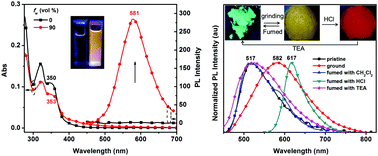Rhodamine-naphthalimide demonstrated a distinct aggregation-induced emission mechanism: elimination of dark-states via dimer interactions (EDDI)†
Abstract
Rhodamine B-naphthalimide (RhB-Naph) demonstrated a distinct aggregation-induced emission (AIE) mechanism, different from the restriction of intramolecular rotations or vibrations as in traditional AIE molecules. The monomers of RhB-Naph were non-emissive, due to the presence of a dark S1 state. Upon molecular aggregation, intermolecular interactions significantly altered the electronic properties of RhB-Naph, leading to the formation of a bright S1 state and endowing RhB-Naph with notable AIE properties. Besides, we demonstrated that RhB-Naph enabled the development of a solid-state three-color fluorescent switch upon multi-external stimuli.



 Please wait while we load your content...
Please wait while we load your content...